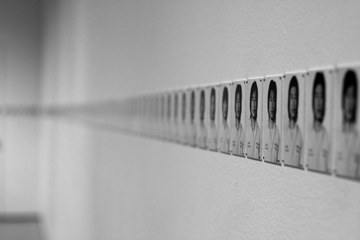
Tehching Hsieh, "One Year Performance 1978–1979" (Cage Piece). This was exhibited at New York's Museum of Modern Art (MoMA) in 2009. Photo: Victor Felder.
In 1996, Jennifer Ringley took a video camera and placed it on her computer. The camera was nothing new: a simple web camera with light broadcasting capabilities. She signed on, told the world she was streaming her life unfiltered, and the Internet birthed one of its first micro-celebrities.
Little more than a decade later, the idea seems simple, boring even, as more and more people have begun broadcasting their lives. But even though the livestream trend was driven by ordinary individuals and not corporate broadcasters, the basic ethos remained the same: one-way communication to multiple individuals by means of video. Rather than presaging the arrival of big brother, Ringley’s project, which she dubbed Jennicam, was a largely a continuation of broadcast media traditions.
For one year, Tehching Hiseh did something similar. For Cage Piece, he had himself photographed once a day for one year in one room. He brushed his teeth, changed his shoes, combed his hair, all for an entire year. By the end of it, he’d completed one of the longest pieces of durational performance art in history.
What influenced Hsieh and Ringley in their work day to day? We could interview them, watch over the documentation, speak with their closest confidantes. But not even Hsieh could probably understand why he did X on this day vs. that day. The artistic process often remains as opaque to the artist as it does to the audience.
The Internet, however, is shedding a little more light on what motivates the artist. But it’s more than just a diary. Instead, artists are letting the Internet take control of their work entirely. This is of course nothing new in the world of performance art, with seminal works like Marina Abramovic’s Rhythm 0 and Regina José Galindo’s Cloth. But the Internet has one key advantage: the simple fact that everything we say and do in this space is archived and recorded systematically.
And the audience can talk back.
Take Nate Hill, for example. I wrote about his work recently for Art 2.1, and his upcoming piece is Punch Me Panda. Using Twitter or text messaging, you can summon his panda to your location of choice. With a body protector and a physically fit body, Punch Me Panda will be available for anyone to let out their aggressions, for just one penny a punch. The creation is his own, but the way it will manifest is up to those who summon him. And how will we know who summoned him and how they reacted? We simply need to search his Twitter feed, archived forever on Google and in the Library of Congress.
And then there’s Marc Horowitz, who’s currently crowdsourcing his life for the entire month of November. Commissioned by Creative Time, The Advice of Strangers is, in simple terms, a crowdsourced life project. Followers vote for him to do anything he asks advice for, and the result is filmed and edited by a two-man crew of Los Angeles filmmakers.
For so long, it has been considered a marker of artistic success when your work is influential, when it shapes the direction of the art world for decades to come. But could it be that the next step in art is to be open to influence? To shape the work at its outset but allow not just artists but anyone watching to influence its ultimate outcome?
I asked Mark what it’s like to cede control to all these individuals he’s never met. He told me, “I had a meltdown recently on this project. When does performance stop and life begin? But then I realized I do have control. It’s not The Decisions of Strangers after all. It’s The Advice of Strangers. We all have performances we do everyday.”





Pingback: Art Under the Influence of Others « Extracts